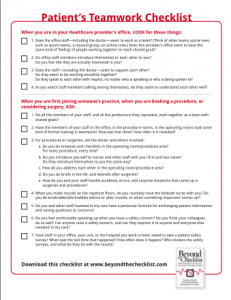Patient Checklist
Get a second opinion. Ask your surgeon how many times he’s performed the operation he is recommending (Learn about Unaccountable Book). Patrol the doses of the medication your physician prescribes and that the nurse administers. Check out whether your doctor has had any malpractice suits filed against her. Search the web to find out about the infection statistics in the hospital to which you are about to be admitted.
These are suggestions we hear more and more often nowadays. Patients are not advised, however, to ask questions that will elicit information about how their doctors, the hospitals they go to, or other healthcare professionals they depend on view one of the major building blocks in the edifice of safety – interprofessional Teamwork.
It is now unarguable that the majority of medical injuries and errors do not stem solely from inattention or from individual failures in technical proficiency, but from failures in teamwork and communication among people who are euphemistically termed the “health care team,” but who are usually a “team” in name only. In every case of patient harm that has made it into the media, failures to communicate critical information, to work as a true team, or to challenge decisions of a medical higher-up were responsible for a preventable death or injury.
These are suggestions we hear more and more often nowadays. Patients are not advised, however, to ask questions that will elicit information about how their doctors, the hospitals they go to, or other healthcare professionals they depend on view one of the major building blocks in the edifice of safety – interprofessional Teamwork.
It is now unarguable that the majority of medical injuries and errors do not stem solely from inattention or from individual failures in technical proficiency, but from failures in teamwork and communication among people who are euphemistically termed the “health care team,” but who are usually a “team” in name only. In every case of patient harm that has made it into the media, failures to communicate critical information, to work as a true team, or to challenge decisions of a medical higher-up were responsible for a preventable death or injury.
Health care organizations are some of the most hierarchical in our society. Lessons in arrogance and deference are part of what is known as the “hidden curriculum” (http://en.wikipedia.org/wiki/Hidden_curriculum) in all of health care professional education. In spite of long-overdue attempts to begin interprofessional education and preach (if not teach) civility in health care institutions, the majority of those in the health professions and occupations are still tutored in toxic hierarchies that are all too often assiduously maintained in the hospitals, clinics, and offices in which they work.
The result:
A doctor blows off the concerned nurse who’s worried he has ordered the wrong dose of a medication. A nurse is fired because she challenged an intern’s incorrect order. Another nurse in the same institution doesn’t make sure a surgeon performs a time-out to assure that the right – rather than wrong –limb is operated on. A resident is afraid to remind an attending to clean his hands after seeing not one but three patients in a row – one of whom has an infection caused by the dreaded hospital superbug Methicillin-resistant Staphylococcus aureus (MRSA). A pharmacist doesn’t question a medication order that doesn’t look right. A housekeeper is afraid to tell a nurses’ aide about troubling behavior he’d noticed when she was in a patient’s room. In health care, toxic hierarchy is truly the gift that keeps on giving.
In each of these cases and many more, the key to keeping patients safe is teamwork and communication. Yet patients are given no tutorials in how to find out whether their primary care provider, cardiologist, surgeon, or pulmonologist knows how to work in or lead a team. To help patients assess whether they are entrusting themselves to a physician, nurse practitioner, physician assistant, physician practice or hospital that practices genuine teamwork, the co-authors of Beyond the Checklist: What Else Health Care Can Learn from Aviation Teamwork and Safety have developed a Patient Teamwork Checklist that may help people better understand the need for teamwork, assess teamwork practices, and advocate for teamwork in healthcare.
Most of us do not find it easy to ask our healthcare providers (HCPs) about the safety of their offices, practices, and inpatient units, or about how their work is organized. Questioning HCPs – about almost anything – is not something most of us have ever learned or been taught. HCPs, as many studies document, also haven’t been taught how to respond well to patients’ questions and concerns (http://jama.jamanetwork.com/article.aspx?articleid=1148155); and they are definitely not accustomed to being asked about safety!
When it comes to safety, patients today are being asked to know and do more to protect themselves than ever before. Regardless of how we as patients feel about whether that should be part of our job descriptions, it is a smart self-defense and preventive strategy to gear ourselves up to do it. Difficult as it may seem, we suggest that you try out this Patient Teamwork Checklist with the healthcare practices that are part of your care. Start with the easier part, the “Look” items. You can make your own short observation-study of health care practices you consider joining, as well as practices with which you may have an established relationship. Most likely, you will discover that the ones where you feel very comfortable and confident demonstrate very good communications and feel like real Teams; the ones that leave you cold, or where you feel like a ‘number’ or an interchangeable ‘complaint’ will not show these qualities.
Health care facilities from hospitals to office practices are getting increasingly urgent messages about our nationwide need to do everything in our power to improve patient safety and eliminate preventable harm. Teamwork and good communication are the most effective tools for achieving this goal. Fortunately, they are both pretty straight-forward to accomplish – but they do require awareness, willingness, training, and constant practice. They are as important as any other clinical skill that we expect our providers to have and to keep updated.
We as patients can help move this vital change forward in health care by using our own safety and communication checklist (PDF), like the one we suggest here. Think about it. Try it – particularly during this National Patient Safety Awareness Week (March 3-9) – and let us know how it worked.
The result:
A doctor blows off the concerned nurse who’s worried he has ordered the wrong dose of a medication. A nurse is fired because she challenged an intern’s incorrect order. Another nurse in the same institution doesn’t make sure a surgeon performs a time-out to assure that the right – rather than wrong –limb is operated on. A resident is afraid to remind an attending to clean his hands after seeing not one but three patients in a row – one of whom has an infection caused by the dreaded hospital superbug Methicillin-resistant Staphylococcus aureus (MRSA). A pharmacist doesn’t question a medication order that doesn’t look right. A housekeeper is afraid to tell a nurses’ aide about troubling behavior he’d noticed when she was in a patient’s room. In health care, toxic hierarchy is truly the gift that keeps on giving.
In each of these cases and many more, the key to keeping patients safe is teamwork and communication. Yet patients are given no tutorials in how to find out whether their primary care provider, cardiologist, surgeon, or pulmonologist knows how to work in or lead a team. To help patients assess whether they are entrusting themselves to a physician, nurse practitioner, physician assistant, physician practice or hospital that practices genuine teamwork, the co-authors of Beyond the Checklist: What Else Health Care Can Learn from Aviation Teamwork and Safety have developed a Patient Teamwork Checklist that may help people better understand the need for teamwork, assess teamwork practices, and advocate for teamwork in healthcare.
Most of us do not find it easy to ask our healthcare providers (HCPs) about the safety of their offices, practices, and inpatient units, or about how their work is organized. Questioning HCPs – about almost anything – is not something most of us have ever learned or been taught. HCPs, as many studies document, also haven’t been taught how to respond well to patients’ questions and concerns (http://jama.jamanetwork.com/article.aspx?articleid=1148155); and they are definitely not accustomed to being asked about safety!
When it comes to safety, patients today are being asked to know and do more to protect themselves than ever before. Regardless of how we as patients feel about whether that should be part of our job descriptions, it is a smart self-defense and preventive strategy to gear ourselves up to do it. Difficult as it may seem, we suggest that you try out this Patient Teamwork Checklist with the healthcare practices that are part of your care. Start with the easier part, the “Look” items. You can make your own short observation-study of health care practices you consider joining, as well as practices with which you may have an established relationship. Most likely, you will discover that the ones where you feel very comfortable and confident demonstrate very good communications and feel like real Teams; the ones that leave you cold, or where you feel like a ‘number’ or an interchangeable ‘complaint’ will not show these qualities.
Health care facilities from hospitals to office practices are getting increasingly urgent messages about our nationwide need to do everything in our power to improve patient safety and eliminate preventable harm. Teamwork and good communication are the most effective tools for achieving this goal. Fortunately, they are both pretty straight-forward to accomplish – but they do require awareness, willingness, training, and constant practice. They are as important as any other clinical skill that we expect our providers to have and to keep updated.
We as patients can help move this vital change forward in health care by using our own safety and communication checklist (PDF), like the one we suggest here. Think about it. Try it – particularly during this National Patient Safety Awareness Week (March 3-9) – and let us know how it worked.





